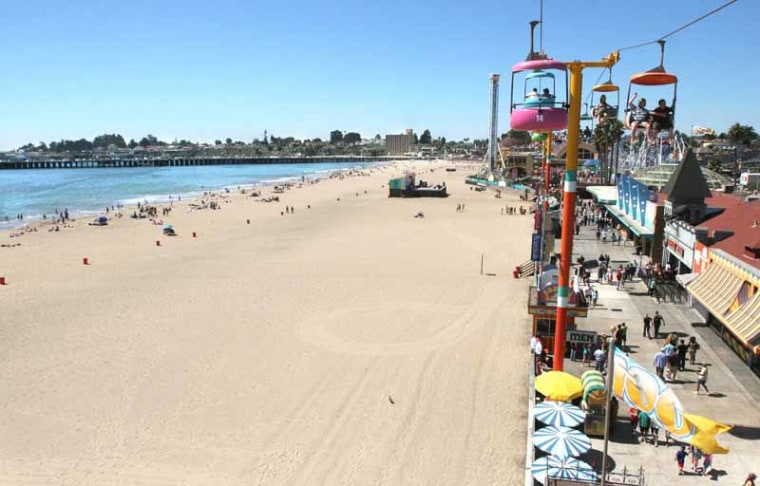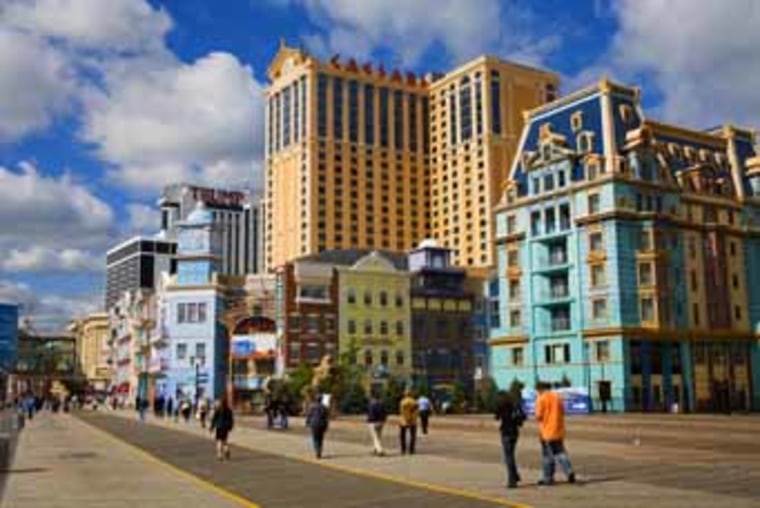For nostalgic Americans, boardwalks are the stuff of summer dreams, mixing memories of salt water taffy at sunset, white-knuckled wooden rollercoaster rides and kids with dogs racing along weathered walkways.
James Lilliefors, author of “America’s Boardwalks, From Coney Island to California,” says boardwalks have always been “bright, alluring, loud, lucrative and very American.”
Still, as Park World magazine reported in 2007, “In the 1920s there were more than 1,500 authentic seaside amusement parks in the United States, today there are less than two dozen.” Despite these dwindling numbers, those that remain are flourishing: Where once boardwalks were merely the venue for the world's greatest oddities, now they have a civic purpose, acting as a nexus for local business and a spur to nostalgia-based urban renewal.
Wildwoods' Boardwalk today touts more rides than Disney Land, and Kemah Boardwalk in Galveston Bay, Texas, opened as recently as 1988, has become the most popular recreational and entertainment park in the Houston area. “Boardwalks were the forerunners of theme parks and mega shopping malls,” says Lilliefors, but the malls didn’t replace them ... the greatest appeal of the boardwalk is largely sensual and a little intangible, the confluence of natural and man-made attractions you don't find in a shopping mall.” Neither have shopping malls spawned entire food franchises, hit songs and starring roles in countless great films.
America’s first boardwalk was actually a temporary structure constructed in 1870 to keep the sand off Atlantic City’s beachfront hotel carpets. It quickly surpassed its practical origins, becoming the most sought after stretch of real estate in Atlantic City, giving it prime placement as the most valuable square in the Parker Brothers game, Monopoly. Similarly, boardwalks across America became a destination's main attraction after the ocean itself. According to Lilliefors, at one time the Atlantic City Boardwalk displayed a "home of the future," the world's largest typewriter, shows with diving horses, kangaroo boxing, and even a reenactment of the Johnstown flood.
From the turn of the century, Brooklyn’s Coney Island also emerged as a vibrant destination for New Yorkers in search of lights, beach and action. In 1927, Coney Island gave the world the Cyclone Rollercoaster, which because one of the most famous of its kind, and the steel Wonder Wheel Ferris Wheel, built in 1920. Lilliefors says, “Coney Island was considered the most dazzling spectacle in the world — lit up, supposedly, by a million light bulbs at a time when electricity was still a novelty.” Though it has lost appeal, recently suffering the sale of Astroland to developers in 2007, the boardwalk and many of the classic boardwalk shops and attractions remain active.
California's “Coney Island of the West,” Santa Cruz, boasts its own Cyclone equivalent, The Giant Dipper. The creator of this 85-year-old wooden coaster, Arthur Looff, said he envisioned a coaster that had “the thrill of a plunge down a mine shaft, a balloon ascent, a parachute jump, airplane acrobatics, a cyclone, a toboggan ride and a ship in a storm.”

With the recent renovation of the Looff Carousel and its original band organ, plus the addition of a ski lift type of transportation above its boardwalk, Santa Cruz Boardwalk says its goal is “keeping our nostalgia current." Where Coney Island and Asbury Park remain shadows of their former glory, the Santa Cruz and Wildwood Boardwalks still host three and nine million yearly visitors respectively.
A connoisseur of U.S. beaches, Dr. Stephen Leatherman, who acquired the moniker “Dr. Beach” for his annual list Dr. Beach’s America’s Best Beaches List, has visited about 650 of the major recreational beaches in the U.S. and knows something about the effects of boardwalk renovation. He says that Rehoboth Beach, Del., Santa Cruz, Calif. and Long Beach, Wash. are among his favorite boardwalks, successful renovations of the Waikiki Beach boardwalk and the reopening of the wooden rollercoaster at Mission Beach, Calif., have made these beaches more family-friendly and helped to bring the crowds back.

The Rehoboth Beach boardwalk is similarly undergoing a full reconstruction that is reportedlyone of Delaware's largest transportation stimulus projects in history, and will replace whole concrete sections with the original-style wood planks.Dr. Leatherman feels that revitalization is necessary because boardwalks “connect everything together ... the boardwalk is a part and parcel of the beach experience.”
When it comes to pop culture, boardwalks have birthed many a touchstone. For instance, salt water taffy reportedly originated in 1883 on the Atlantic City Boardwalk after a storm flooded a candy store. And then there are Boardwalk Fries. Trends come and go but the boardwalk stays. And so do its attractions: In fact, the Cyclone rollercoaster in Coney Island occupies the exact space that contained the world's very first rollercoaster the Switchback Railway, built in 1884. The convergence of rich historical elements like these and consistent efforts to refresh and expand are what will keep boardwalks a thriving focal point of beach towns across America.
